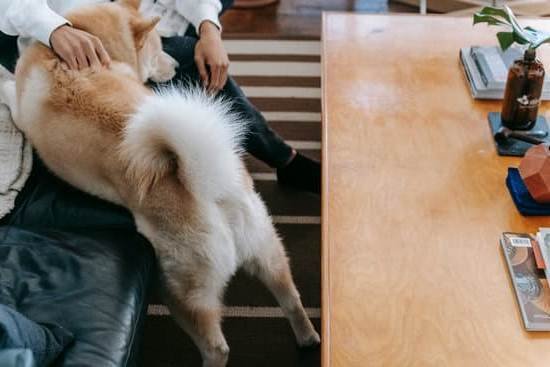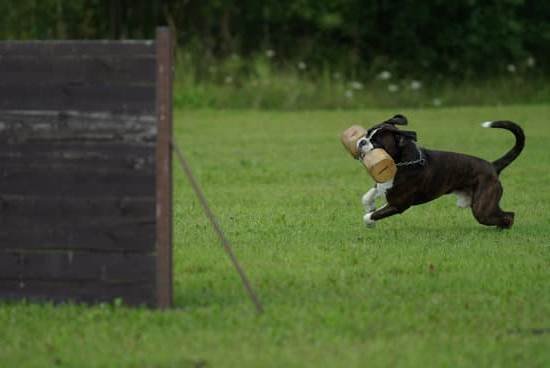Are you wondering, “How do I train my dog to ring a bell“? Training your dog to ring a bell can be a game-changer in developing communication and potty training skills. In this article, we will guide you through the process of teaching your furry friend to use a bell and highlight the numerous benefits that come with it.
The first step in training your dog to ring a bell is understanding the advantages of this skill. From signaling when they need to go outside to communicating their needs more effectively, teaching your dog to ring a bell can improve both their behavior and your relationship with them. This training technique can also be especially helpful for puppies or dogs with mobility issues.
In the upcoming sections, we will cover everything from choosing the right bell and getting started with training to troubleshooting common challenges. By following our comprehensive guide, you’ll be on your way to successfully teaching your dog how to use a bell in no time. Let’s explore the world of bell training for dogs and unlock its many benefits together.
Choosing the Right Bell
When it comes to training your dog to ring a bell, choosing the right bell is essential for ensuring success in the training process. There are several types of bells available on the market, and selecting the perfect one for your dog can make a significant difference in how quickly and effectively they learn to associate bell ringing with going outside.
One popular option for bell training is using a sleigh bell attached to a strap or rope. Sleigh bells produce a distinct sound that is easily recognizable to most dogs, making them an excellent choice for training purposes. Another option is a jingle bell, which has a lighter and higher-pitched sound compared to sleigh bells. Some pet owners also opt for electronic doorbells or communication devices specifically designed for dog training.
When selecting a bell for your dog, consider their size and temperament. For smaller dogs, lightweight options such as jingle bells may be more suitable, while larger dogs may respond better to the louder sounds produced by sleigh bells. Additionally, choose a bell that is durable and can withstand regular use without breaking or becoming damaged.
Ensuring that the chosen bell is easily accessible to your dog is also important. Whether using a strap or attaching it directly to the door handle, the bell should be positioned at an appropriate height so that your dog can readily reach it when signaling their need to go outside. Overall, selecting the right bell involves considering factors such as sound quality, durability, and accessibility in order to optimize the training experience for your dog.
| Types of Bells | Selection Considerations |
|---|---|
| Sleigh Bells | Louder sound; great for larger dogs |
| Jingle Bells | Lighter and higher-pitched; suitable for smaller dogs |
| Electronic Doorbells | Specially designed for dog training; different sound options available |
Getting Started
Now that you understand the benefits of training your dog to ring a bell, it’s time to take the first steps in the training process. Before you dive into teaching your dog the actual bell ringing behavior, it’s important to choose the right bell for your furry friend. There are several types of bells available, including jingle bells, service bells, and even doorbells designed for dogs.
Consider the size and sound of the bell, as well as its durability and safety features. Once you’ve chosen the perfect bell for your pup, it’s time to move on to the initial stages of training.
To begin training your dog to ring a bell, start by getting them familiar with the bell itself. Introduce the bell to your dog and allow them to sniff and investigate it. This will help them become comfortable with the object before you start associating it with a specific behavior.
Next, place the bell near the door that leads outside or to where your dog usually goes potty. Encourage your dog to approach and interact with the bell by using treats or toys to make it an appealing object.
It is crucial during this initial phase of training that you are patient and consistent. Use positive reinforcement techniques such as treats and praise when your dog shows interest in or touches the bell.
Be prepared for repetition and remember that each dog learns at their own pace. Keep in mind that consistency is key when training any new behavior, so be sure to dedicate regular time each day to work on building this association between ringing the bell and going outside.
Positive Reinforcement
Understanding Positive Reinforcement
Positive reinforcement is a powerful training technique that rewards your dog for displaying a desired behavior. When it comes to bell training, positive reinforcement involves giving your dog treats and praise every time they ring the bell. This helps create a positive association with the action, making them more likely to repeat it in the future.
Choosing the Right Treats
When using treats for positive reinforcement during bell training, it’s important to select treats that are highly appealing to your dog. These can be small, bite-sized pieces of their favorite food or special training treats specifically designed for rewarding good behavior. The key is to find something that your dog loves and is willing to work for in order to motivate them to ring the bell.
Using Praise Effectively
or “You’re so clever.” This combination of treats and praise will reinforce the idea that ringing the bell leads to positive outcomes, making it more likely that they will continue doing so. Remember, consistency is key when using positive reinforcement in bell training.
Establishing a Routine
When it comes to training your dog to ring a bell, consistency is key. Establishing a routine not only helps your dog understand what is expected of them, but it also reinforces the behavior you are trying to teach. Here are some tips on creating a consistent schedule for bell training:
- Set specific times for bell training: Choose times during the day when you can dedicate focused attention to teaching your dog to ring the bell. This could be after meals, before going for a walk, or before bedtime.
- Use the same door each time: It’s important to choose one specific door that you want your dog to associate with ringing the bell. Whether it’s the front door or the back door, consistency is key in helping them understand where they should go when they need to go out.
- Be patient and persistent: Training takes time and patience. Stick to your schedule and be persistent in reinforcing the behavior you want. Remember that every dog learns at their own pace, so don’t get discouraged if progress is slow at first.
Creating a consistent schedule for bell training will help your dog understand what is expected of them and make it easier for them to learn the desired behavior.
Remember, every dog is different and may require different lengths of time spent on establishing this new routine. Be patient and consistent with your efforts, and soon enough your furry friend will know exactly how to signal their need to go outside by ringing a bell.
Troubleshooting
Distractions and Lack of Interest
One common challenge in bell training is dealing with distractions and lack of interest from your dog. If your dog seems uninterested or easily distracted during bell training sessions, it may be helpful to identify what triggers their disinterest. Some dogs may be more motivated by certain treats, toys, or praise, so try experimenting with different incentives to keep your dog engaged. Additionally, minimizing distractions in the training environment can also help improve focus and concentration.
Accidental Ringing or Excessive Ringing
Another common issue that pet owners encounter during bell training is accidental ringing or excessive ringing. This occurs when the dog rings the bell for reasons other than signaling the need to go outside, such as out of boredom or seeking attention.
To address this problem, consider adding a cue or command that indicates when it’s time to ring the bell for potty breaks only. Use positive reinforcement consistently when your dog rings the bell for the right reason and ignore accidental or excessive ringing.
Persistence and Patience
Finally, persistence and patience are key when addressing challenges in bell training. Every dog learns at their own pace, so it’s important not to get discouraged if progress seems slow. Consistency in training methods and positive reinforcement will help reinforce the desired behavior over time. Remember that each setback presents an opportunity to reassess your approach and make any necessary adjustments to better support your dog’s learning process.
By addressing these common challenges with patience and perseverance, you can successfully overcome setbacks in bell training and continue making progress towards achieving effective communication with your four-legged friend on potty breaks.
Taking It to the Next Level
Taking bell training to the next level involves advancing the training to include specific commands or actions that are associated with ringing the bell. This stage of training adds complexity and depth to your dog’s understanding of the bell as a communication tool, as well as further reinforcing their obedience and responsiveness to your cues.
One way to take bell training to the next level is by incorporating specific verbal cues or hand signals that prompt your dog to ring the bell. For example, you can pair a verbal command such as “ring the bell” with pointing at the bell, or use a hand signal that signifies the action of ringing the bell.
By doing this, you are teaching your dog to understand not only the physical act of ringing the bell, but also linking it with a specific command or signal from you.
In addition to adding specific commands or actions, you can also introduce different scenarios or contexts in which your dog should ring the bell. For instance, you can teach them to ring the bell when they need to go outside for a bathroom break, when they want food or water, or when they need attention and playtime. By associating different situations with bell ringing, your dog learns to communicate their needs and desires more effectively.
| Advancing Bell Training | Specific Commands/Actions |
|---|---|
| Incorporate verbal cues/hand signals | Prompting dogs to ring the bell with specific commands/symbols |
| Introduce different scenarios/context | Teaching dogs when and why they should ring the bell for various needs |
Celebrating Success
After putting in the time and effort to train your dog to ring a bell, it’s important to celebrate their progress and recognize their hard work. Celebrating success is an essential part of the training process as it reinforces positive behavior and encourages your dog to continue learning. By acknowledging their achievements, you are providing them with the motivation to keep up the good work.
One way to celebrate your dog’s success in bell training is by giving them verbal praise and affection every time they successfully ring the bell. This positive reinforcement helps your dog understand that ringing the bell is a desirable behavior. Additionally, you can also give them their favorite treats as a reward for their accomplishment. By associating bell ringing with something enjoyable, your dog will be more inclined to continue doing so.
Another way to celebrate your dog’s progress in bell training is by incorporating specific commands or actions into the routine. For example, once your dog has mastered ringing the bell to go outside, you can introduce a new command such as sitting or staying by the door after they ring the bell. This not only adds another layer of complexity to their training but also allows you to communicate with your dog more effectively.
Recognizing and rewarding your dog’s progress in bell training not only strengthens your bond with them but also shows them that their efforts are appreciated. It’s important to remain patient and consistent throughout the training process and celebrate each milestone along the way. With dedication and positive reinforcement, your furry companion will become proficient in ringing a bell in no time.
Conclusion
Training your dog to ring a bell can be a valuable skill that enhances communication between you and your furry friend. By understanding the benefits of this training, choosing the right bell, and following the steps outlined in this guide, you can successfully teach your dog to use a bell to communicate their needs. Positive reinforcement, consistency, troubleshooting common challenges, advancing the training, and celebrating success are all crucial aspects of this process.
One important aspect not to overlook is the value of patience when training your dog to ring a bell. Dogs learn at different paces, so it’s essential to be patient and consistent in your approach. Understand that setbacks may occur, but with perseverance and encouragement, most dogs will eventually catch on.
In conclusion, training your dog to ring a bell can improve their ability to communicate with you. It is also an enriching experience for both you and your pet as it strengthens your bond. With dedication, positive reinforcement, and consistency, you can successfully train your dog to ring a bell and enhance your relationship with them. So don’t hesitate to start this training process – it will be worth it in the end.
Frequently Asked Questions
How Do You Potty Train a Puppy With Bells?
Potty training a puppy with bells involves hanging a set of bells on the door handle that leads outside. Every time you take your puppy out to potty, encourage them to nudge the bells with their nose or paw.
How Long Does It Take to Bell Train a Dog?
The length of time it takes to bell train a dog can vary depending on the individual dog. Some puppies may pick up on the bell training in just a few days, while others may take a few weeks to fully grasp the concept.
Is Bell Training Good for Dogs?
Bell training can be beneficial for dogs as it provides them with a clear signal to indicate when they need to go outside. It can also help prevent accidents inside the house by giving dogs a way to communicate their needs effectively.

Welcome to the blog! I am a professional dog trainer and have been working with dogs for many years. In this blog, I will be discussing various topics related to dog training, including tips, tricks, and advice. I hope you find this information helpful and informative. Thanks for reading!





